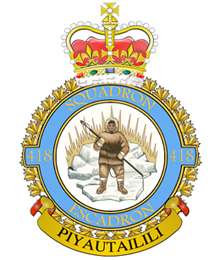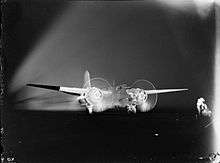No. 418 Squadron RCAF
No. 418 "City of Edmonton" Search And Rescue Squadron RCAF is a unit of the Royal Canadian Air Force, formed during World War II.
| No. 418 Squadron RCAF "City of Edmonton" | |
|---|---|
 | |
| Active |
|
| Country | |
| Branch | |
| Type | 1941–45 Intruder 1946–94 Tactical bomber/transport 2019– Search & rescue/transport |
| Part of | (1941–45) RCAF Article XV squadrons, attached to the RAF for operational purposes |
| Motto(s) | Piyautailili (Inuktitut: "Defend even unto death") |
| Battle honours | Defence of Britain 1944, Fortress Europe 1942–44, France & Germany 1944–45, Normandy 1944, Rhine 1945 |
History

418 Squadron RCAF was Canada's highest-scoring squadron in World War II, in terms of both air-to-air and air-to-ground kills, and in terms of both day and night operations. The Squadron's most active period was 1944, when assigned to Intruder and Ranger sorties across occupied Europe.
These sorties, made at low level to escape radar detection, took 418 Squadron crews into the heart of enemy territory, there to wreak havoc among departing or returning Luftwaffe night-fighter crews (Intruder sorties), or to shoot up enemy airfields, or indeed anything else of military value, in Ranger sorties.
As an Intruder squadron, 418 Sqn's aircraft did not carry radar sets - even at night targets had to be found, identified, lined up, and attacked all with the naked eye. The squadron's success speaks volumes of the skill of its crews that it achieved such success under these conditions.
A few short months after the war, the squadron was recalled up and deployed to duty now flying the B-25 Mitchell in the tactical bomber role from the Edmonton Municipal Airport. At the time the majority of Canada's air defence was made up of reservists and 418 was no exception. Students, businessmen, and professionals in the Edmonton area gave up their spare time to protect Canada's north. By 1958, defence cuts reduced the squadron's activities to a transport role flying the Single Otter and C-45 Expeditor from RCAF Station Namao. Its duties ranged from aid to the civil power to aerial re-supply.
Upon unification of the forces the squadron converted to the DeHavilland Twin Otter. With the advent of the Twin Otter, the Squadron's role was redefined as search and rescue and light tactical transport. No. 418 City of Edmonton Squadron is currently inactive. The CC-138 Twin Otter's flying with No. 440 Red Bat squadron out of Yellowknife, NWT.
There is currently a presence in the Alberta Aviation Museum on Kingsway Avenue in Edmonton, Alberta.
Squadron Re-Establishment
The re-establishment of 418 Squadron occurred on March 13, 2019.[1] Lieutenant-General Al Meinzinger, commander of the RCAF, and Lieutenant-Colonel Jeffers co-signed the documents appointing Lieutenant-Colonel Jeffers as commanding officer during a brief ceremony at 19 Wing Comox, British Columbia—418 Squadron’s new home—on July 11, 2019. 418 Search and Rescue Operational Training Squadron will fill an essential role for the aircrew and maintainers of the CC-295, the RCAF’s newest fixed-wing search and rescue aircraft. The squadron’s new simulators will improve search and rescue skills and harness the capabilities of the CC-295 aircraft, while forming the heart of the Search and Rescue Centre of Excellence at 19 Wing Comox.
References
- Government of Canada, National Defence (11 July 2019). "News Article | 418 Squadron flies again". www.rcaf-arc.forces.gc.ca. Retrieved 11 July 2019.
External links
| Wikimedia Commons has media related to 418 Squadron RCAF. |
- Squadron history at Canadian Wings (DEAD LINK)